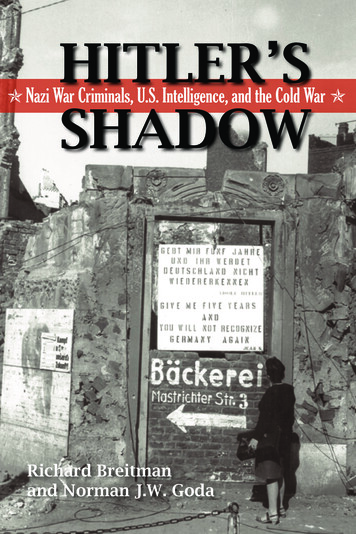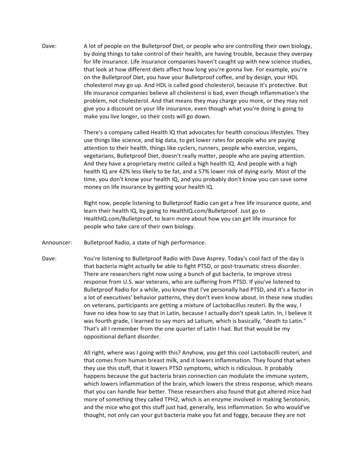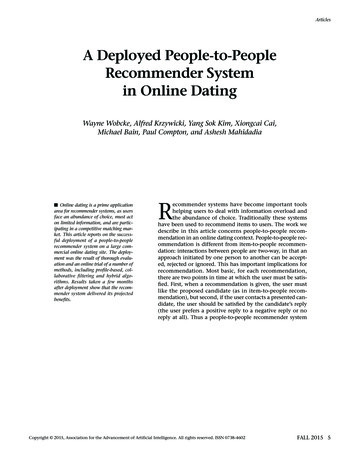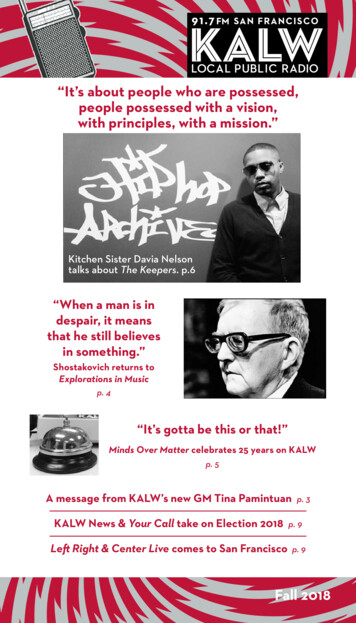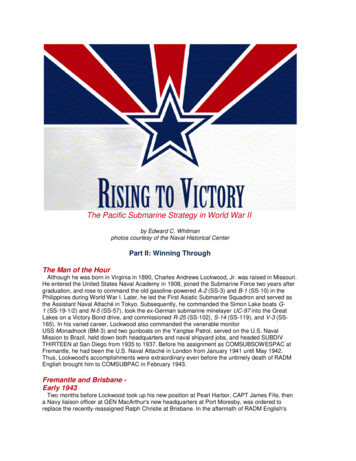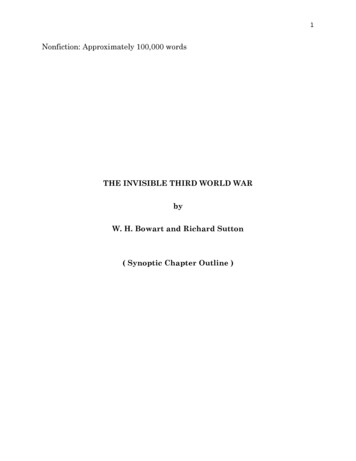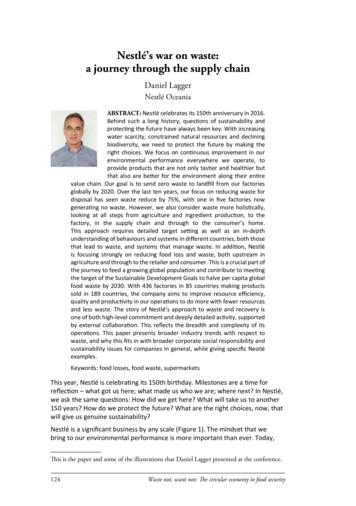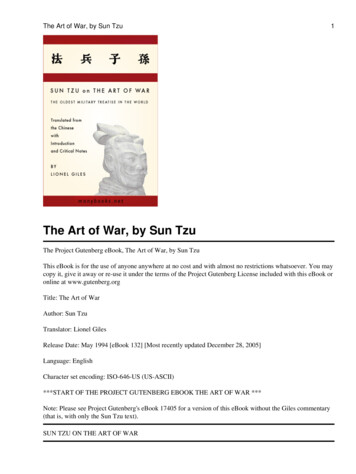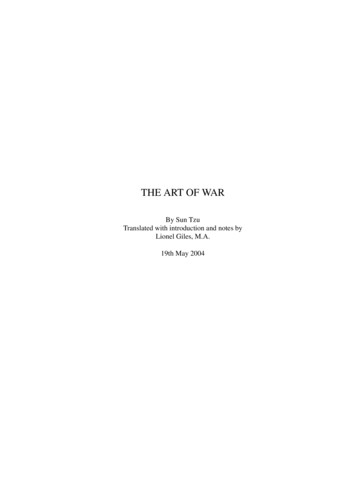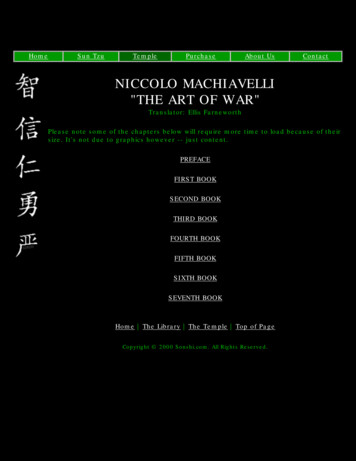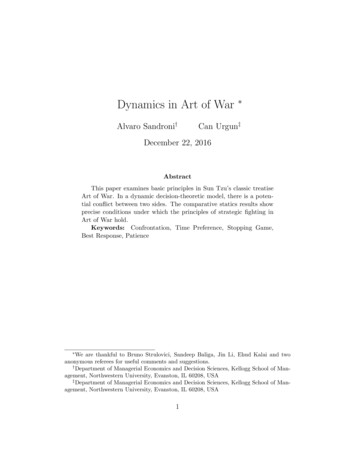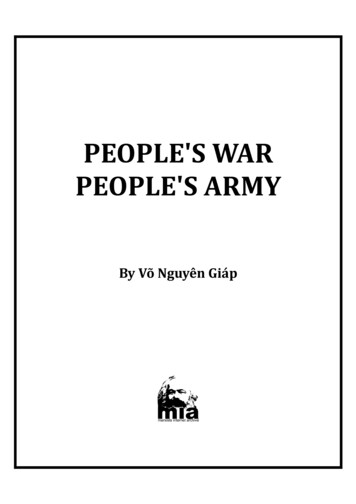
Transcription
PEOPLE'S WARPEOPLE'S ARMYBy Võ Nguyên Giáp
Võ Nguyên GiápPeople’s War, People’s Army / Võ Nguyên GiápOriginal title: Chiến tranh nhân dân, quân đội nhân dânFirst published in English by Foreign Languages Publishing House, Hanoi, 1961.Published by the Marxists Internet Archive (www.marxists.org), 2014.
PEOPLE'S WARPEOPLE'S ARMYBy Võ Nguyên Giáp
CONTENTSForeword to the 1961 English-languageEdition 1The Vietnamese people's war of liberationagainst the French imperialists and theAmerican interventionists (1945-1954) 3People's war, people s army 17The great experiences gained by our Partyin leading the armed struggle and buildingrevolutionary armed force 33Dien Bien Phu 77
Foreword to the 1961 English-languageEditionWe are very pleased to publish the English translation of a series of articles by GeneralVo Nguyen Giap, member of the Political Bureau of the Central Committee of the VietNam Workers' Party, Vice-Premier and Minister for National Defence of the DemocraticRepublic of Viet Nam, Commander-in-Chief of the Viet Nam People's Army.In these articles, the author introduces the liberation war waged by the Vietnamesepeople, the features of that war, and deals with the reasons for victory : mobilisation ofthe entire people, setting up of a people's army, merging of all patriotic organisations andpeople into a united national front, clear sighted leadership of the Party of the workingclass. It lays particular stress on the problem of organisation and direction of therevolutionary armed forces of Viet Nam. In a word, it is the combination of experiencesgained by the Vietnamese people in the course of a long struggle against colonialism, fornational independence, struggle which ended in 1954 with the brilliant Dien Bien Phuvictory and the signing of the Geneva Agreements.Publication of this book is most timely.It is true that since the end of World War II, the maps of Asia, Africa and Latin Americahave been subject to radical changes, other countries will soon be independent andcolonialism is unquestionably doomed to collapse. It is no less true that great obstaclesstill stand in the way of the peoples struggling for their liberation. The Algerian war hasjust entered its seventh year. The so-called "U.N. action" in the Congo has turned out tobe an imperialist plot against Lumumba's motherland. Cuba is subject to dailyprovocations by the U.S.A. Half of Viet Nam's territory is still under the heel of a newtype colonialism "made in U.S.A."We hope that all our friends who, like us, are still suffering from imperialist designs andthreats will find in the "People's War, People's Army" what we ourselves have found:further reasons for confidence and hope.FOREIGN LANGUAGES PUBLISHING HOUSE1
2
THE VIETNAMESE PEOPLE'S WAR OFLIBERATION AGAINST THE FRENCHIMPERIALISTS AND THE AMERICANINTERVENTIONISTS (1945-1954)IA FEW HISTORICAL AND GEOGRAPHICALCONSIDERATIONSViet Nam is one of the oldest countries in South-east Asia.Stretching like an immense S along the edge of the Pacific, it includes Bac Bo or NorthViet Nam which, with the Red River delta, is a region rich in agricultural and industrialpossibilities, Nam Bo or South Viet Nam, a vast alluvial plain furrowed by the arms ofthe Mekong and especially favourable to agriculture, and Trung Boor Central Viet Nam,a long, narrow belt of land joining them. To describe the shape of their country, theVietnamese like to recall an image familiar to them : that of a shoulder pole carrying abasket of paddy at each end.Viet Nam extends over nearly 330.000 square kilometres on which lives a population ofapproximately 3o million inhabitants. During its many thousands of years old history, theVietnamese people have always been able to maintain an heroic tradition of struggleagainst foreign aggression. During the 13th century in particular, they succeeded inthwarting attempts at invasion by the Mongols who had extended their domination overthe whole of feudal China.From the middle of the 19th century, the French imperialists began undertaking theconquest of the country. Despite resistance lasting dozens of years, Viet Nam was3
progressively reduced to the state of a colony, thereafter to be integrated in French IndoChina' with Cambodia and Laos. But from the first day of French aggression, the nationalliberation movement of the Vietnamese people unceasingly developed. The repressionwhich attempted to stifle this movement only stirred it up the more; so much so, that afterthe First World War, it began to take on a powerful mass character and had already wonover wide circles of the intellectual and petty bourgeois levels, while penetrating deeplyinto the peasant masses as well as into the working class which was then beginning toform. The year 1930 saw another step forward with the founding of the IndochineseCommunist Party, now the Viet Nam Workers' Party which took upon itself the missionof leading the national democratic revolution of the Vietnamese people against theimperialists and the feudal landlord class.Just after the launching of the Second World War in 1939, France was occupied by theNazis, while Viet Nam was progressively becoming a colony of the Japanese fascists.The Party was able in good time to appreciate the situation created by this newdevelopment. Estimating that a new cycle of war and revolution had begun, it set as atask for the whole nation the widening of the anti-imperialist national united front, thepreparation of armed insurrection and the overthrow of the French and Japaneseimperialists in order to re-conquer national independence. The Viet Nam Doc Lap DongMinh (League for the Independence of Viet Nam, abbreviated to Viet Minh) was foundedand drew in all patriotic classes and social strata. Guerrilla warfare was launched in theHigh Region of Bac Bo. A free zone was formed.In August 1945, the capitulation of the Japanese forces before the Soviet Army and theAllied forces, put an end to the world war. The defeat of the German and Nippon fascistswas the beginning of a great weakening of the capitalist system. After the great victory ofthe Soviet Union, many people's democracies saw the light of day. The socialist systemwas no longer confined within the frontiers of a single country. A new historic era wasbeginning in the world.In view of these changes, in Viet Nam, the Indo-chinese Communist Party and the VietMinh called the whole Vietnamese nation to general insurrection. Everywhere, the peoplerose in a body. Demonstrations and displays of force followed each other uninterruptedly.In August, the Revolution broke out, neutralising the bewildered Nippon troops,overthrowing the pro-Japanese feudal authorities, and installing people's power in Hanoiand throughout the country, in the towns as well as in the countryside, in Bac Bo as wellas in Nam Bo. In Hanoi, the capital, in September 2nd, the provisional gouvernment wasformed around President Ho Chi Minh ; it presented itself to the nation, proclaimed theindependence of Viet Nam, and called on the nation to unite, to hold itself in readiness todefend the country and to oppose all attempts at imperialist aggression. The DemocraticRepublic of Viet Nam was born, the first people's democracy in South-east Asia.But the imperialists intended to nip the republican regime in the bud and once againtransform Viet Nam into a colony. Three weeks had hardly gone by when, on September23rd, 1945, the French Expeditionary Corps opened fire in Saigon. The wholeVietnamese nation then rose to resist foreign aggression. From that day, began a war of4
national liberation which was to be carried on for nine years at the cost of unprecedentedheroism and amidst unimaginable difficulties, to end by the shining victory of our peopleand the crushing defeat of the aggressive imperialists at Dien Bien Phu.But at a time when, in the amazing enthusiasm aroused by the August Revolution, theVietnamese people were closing their ranks around the provisional government, a newfactor intervened which was to make the political situation more difficult and morecomplex. According to the terms of an agreement between the Allies, in order to receivethe Japanese surrender, the Chinese Kuomintang forces entered in a body in the part ofViet Nam situated north of the 16th parallel, while the British forces landed in the South.The Chiang Kai-shek troop took advantage of the opportunity to pillage the populationand sack the country, while using every means to help the most reactionary elementsamong the Vietnamese bourgeois and landlords - the members of the Viet Nam QuocDan Dang (the Vietnamese Kuomintang) and the pro-Japanese Phuc Quoc (VietnameseNational Restoration Party) - to stir up trouble throughout the country. After occupyingthe five frontier provinces, they provoked incidents even in the capital, and feverishlyprepared to overthrow people's power. In the South, the British actively exertedthemselves to hasten the return of the French imperialists. Never before had there been somany foreign troops on the soil of Viet Nam. But never before either, had the Vietnamesepeople been so determined to rise up in combat to defend their country.These are the broad outlines of the historical and geographical conditions indispensableto an understanding of the unfolding of the war of national liberation of the Vietnamesepeople.IISUMMARY OF THE PROGRESS OF THE WAR OF NATIONALLIBERATIONAt the outset of the war, the French imperialists' scheme was to rely upon the Britishtroops to re-conquer Nam Bo and afterwards to use it as a springboard for preparing theirreturn to the North. They had shamefully capitulated before the Japanese fascists, butafter the ending of the world war, they considered the resumption of their place at thehead of their former colony as an indisputable right. They refused to admit that in themeantime the situation had radically changed.In September 1945, French colonial troops armed by the British and soon strengthened bythe French Expeditionary Corps under the command of General Leclerc, launchedaggression in Saigon, with the direct support of the British army. The population of NamBo immediately rose up to fight. In view of the extreme weakness of its forces at thebeginning, people's power had to withdraw to the countryside after waging heroic streetfights in Saigon and in the large towns. Almost the whole of the towns and important5
lines of communication in Nam Bo and the South of Trung Bo gradually fell into thehands of the adversary.The colonialists thought they were on the point of achieving the re-conquest of Nam Bo,and General Leclerc declared that occupation and pacification would be completed in tenweeks. But events took quite a different turn. Confident of the support of the wholecountry, the southern population continued the fight. In all the campaigns inNam Bo the guerrilla forces were going from strength to strength, their bases were beingconsolidated and extended and people's power was maintained and strengthened duringthe nine years of the Resistance, until the re-establishment of peace.Knowing that the invasion of Nam Bo was only the prelude to a plan of aggression by theFrench imperialists, pour Party guided the whole nation toward preparing a long-termresistance. In order to assemble all the forces against French imperialism, the Partyadvocated uniting all the elements that could be united, neutralising all those that couldbe neutralised, and widening the National United Front by the formation of the Lien Viet(Viet Nam People's Front) urgently organising general elections with universal suffragein order to form the first National Assembly of the Democratic Republic of Viet Namresponsible for passing the Constitution and forming a widely representative resistancegovernment grouping the most diverse elements including even those of the Viet NamQuoc Dan Dang (the Vietnamese Kuomintang). At that time, we avoided all incidentswith the Chiang Kai-shek troops.The problem then before the French Expeditionary Corps was to know whether it wouldbe easy for them to return to North Viet Nam by force. It was certainly not so, becauseour forces were more powerful there than in the South. For its part, our Governmentintended doing everything in its power to preserve peace so as to enable the newlycreated people's power to consolidate itself and to rebuild the country devastated by longyears of war. It was thus that negotiations which ended in the Preliminary Agreement ofMarch 6th 1946, took place between the French colonialists and our Government.According to the terms of this convention, limited contingents of French troops wereallowed to station in a certain number of localities in North Viet Nam in order to cooperate with the Vietnamese troops in taking over from the repatriated Chiang Kai-shekforces. In exchange, the French Govern-ment recognised Viet Nam as a free state, havingits own government, its own national assembly, its own army and finances, and promisedto withdraw its troops from Viet Nam within the space of five years. The political statusof Nam Bo was to be decided by a referendum.Relations between the Democratic Republic of Viet Nam and France were then at acrossroads. Would there be a move towards consolidation of peace or a resumption ofhostilities? The colonialists considered the Preliminary Agreement as a provisionalexpedient enabling them to introduce part of their troops into the North of Viet Nam, adelaying stratagem for preparing the war they intended to continue. Therefore, the talks atthe Dalat Conference led to no result and those at the Fontainebleau Conference resultedonly in the signing of an unstable modus vivendi. During the whole of this time, thecolonialists partisans of war were steadily pursuing their tactics of local encroachments.6
Instead of observing the armistice, they continued their mopping-up operations in NamBo, and set up a local puppet government there; in Bac Bo they increased provocationsand attacked a certain number of provinces, pillaging and massacring the population ofthe Hongai mining area, and everywhere creating an atmosphere of tension preparatory toattacks by force.Loyal to its policy of peace and independence, our Government vainly endeavoured tosettle conflicts in a friendly manner, many times appealing to the French Governmentthen presided over by the S.F.I.O. (Socialist Party) to change their policy in order toavoid a war detrimental to both sides. At the same time we busied ourselves withstrengthening our rear with a view to resistance. We obtained good results in intensifyingproduction. We paid much attention to strengthening national defence. The liquidating ofthe reactionaries of the Viet Nam Quoc Dan Dang was crowned with success and wewere able to liberate all the areas which had fallen into their hands.In November 1946, the situation worsened. The colonialists by a coup de force inHaiphong seized the town. After engaging in street fights, our troops withdrew to thesuburbs. In December, the colonialists provoked tension in Hanoi, massacred civilians,seized a number of public offices, sent an ultimatum demanding the disarming of ourself-defence groups and the right to ensure order in the, town, and finally provoked armedconflict. Obstinately the colonialists chose war which led to their ruin.On December 19th, resistance broke out throughout the country. The next day, in thename of the Party and of the Government, President Ho Chi Minh called on the wholepeople to rise up to exterminate the enemy and save the country, to fight to the last dropof blood, and whatever the cost, to refuse re-enslavement.At the time when hostilities became generalised throughout the country, what was thebalance of forces? From the point of view of material, the enemy was stronger than us.Our troops were thus ordered to fight the enemy wherever they were garrisoned so as toweaken them and prevent them spreading out too rapidly, and thereafter, when conditionsbecame unfavourable to us, to make the bulk of our forces fall back towards our rear inorder to keep our forces intact with a view to a long-term resistance. The most gloriousand most remarkable combats took place in Hanoi, where our troops succeeded in firmlyholding a huge sector for two months before with-drawing from the capital unhurt.The whole Vietnamese people remained indissolubly united in a fight to the death inthose days when the country was in danger. Replying to the appeal by the Party, theyresolutely chose the path of Freedom and Independence. The central government, havingwithdrawn to bases in the mountainous region of Viet Bac, military zones - soon united ininter-zones - were formed, and the power of local authorities was strengthened formobilising the whole people and organising the resistance. Our government continuedappealing to the French government not to persist in their error and to reopen peacefulnegotiations. But the latter under the pretext of negotiation demanded the disarming ofour troops. We replied to the colonialists' obstinacy by intensifying the resistance.7
In fact, the French High Command began regrouping forces to prepare a fairly biglightning offensive in the hope of ending the war. In October 1947, they launched a bigcampaign against our principal base, Viet Bac, in order to annihilate the nerve centre ofthe resistance and destroy our regular forces. But this large-scale operation ended in acrushing defeat. The forces of the Expeditionary Corps suffered heavy losses withoutsucceeding in causing anxiety to our leading organisations or impairing our regular units.It was a blow to the enemy's strategy of a lightning war and a rapid solution. Our peoplewere all the more determined to persevere along the path of a long-term resistance.From 1948, realising that the war was prolonging itself, the enemy changed their strategy.They used the main part of their forces for "pacification" and for consolidating thealready occupied areas, in Nam Bo especially, applying the principle: fight Vietnamesewith Vietnamese, feed war with war. They set up a puppet central government, activelyorganised supplementary local units, and indulged in economic pillage. They graduallyextended their zone of occupation in the North and placed under their control the majorpart of the Red River delta. During all these years, the French Expeditionary Corpsfollowed a procedure of great dispersion, scattering their forces in thousands of militarypoststooccupyterritoryand control the localities. But ever-growing military and financial difficulties graduallyled the French imperialists to let the American imperialists interfere in the conflict.The enemy having altered their strategy, we then advocated the wide development ofguerrilla warfare, transforming the former's rear into our front line. Our units operated insmall pockets, with independent companies penetrating deeply into the enemy-controlledzone to launch guerrilla warfare, establish bases and protect local people's power. It wasan extremely hard war generalised in all domains: military, economic and political. Theenemy mopped-up, we fought against mopping-up. They organised supplementary localVietnamese troops and installed puppet authorities; we firmly upheld local people'spower, overthrew men of straw, eliminated traitors and carried out active propaganda tobring about the disintegration of the supplementary forces. We gradually formed anetwork of guerrilla bases. On the map showing the theatre of operations besides the freezone, "red zones", which ceaselessly spread and multiplied, began to appear right in theheart of the occupied areas. The soil of the fatherland was being freed inch by inch rightin the enemy's rear lines. There was no clearly-defined front in this war. It was therewhere the enemy was. The front was nowhere, it was everywhere. Our new strategycreated serious difficulties for the enemy's plan to feed war with war and to fightVietnamese with Vietnamese and finally brought about their defeat.The centre of gravity of the front was gradually moving towards the enemy's rear. Duringthis time, the free zone was continually being consolidated. Our army was growing in thestruggle. The more our guerrillas developed and the more our local units grew, the morewe found ourselves able to regroup our forces. At the end of 1948 and the beginning of1949, for the first time we launched small campaigns which inflicted considerable losseson our adversary. The imperialists were beginning to feel great anxiety. The commissionof enquiry presided over by General Revers made a fairly pessimistic report8
which came to the conclusion that it was necessary to ask the United States for more aid.1949 saw the brilliant triumph of the Chinese Revolution and the birth of the People'sRepublic of China. This great historic event which altered events in Asia and the world,exerted a considerable influence on the war of liberation of the Vietnamese people. VietNam was no longer in the grip of enemy encirclement, and was henceforthgeographically linked to the socialist bloc.At the beginning of 1950, the Democratic Republic of Viet Nam was officiallyrecognised by the People's Republic of China, the Soviet Union and the brother countries.The following year, the second Congress of the Indochinese Communist Party decided toalter the name of the Party and founded the Viet Nam Workers' Party. The Viet Minh andthe Lien Viet were amalgamated. In 1953, the Party and the Government decided to carryout agrarian reform in order to liberate productive forces and give a more vigorousimpulse to the Resistance. All these facts contributed to shaping to our advantage thecourse of our struggle.In effect, 1950 marked the opening of a new phase in the evolution of our longResistance. During the winter, in the frontier campaign, for the first time, we opened arelatively big counter-attack which resulted in the liberation of the provinces of CaoBang, Lang Son and Lao Cai. Immediately after, we began a series of offensiveoperations on the delta front.The enemy, routed, sent General De Lattre de Tassigny to Indo-China. The military aidgranted by the United States following an agreement signed in 1950, was on the increase.The aggressive war waged by the French colonialists gradually became a war carried outwith "U.S. dollars" and "French blood ''. It was really a 'dirty war'.De Lattre's plan, approved by Washington, provided for a strong line of bunkers in theRed River delta to stop our progress, and for a regrouping of forces in order to launchviolent mopping-up operations so as at all costs to 'pacify' the rear and create the rightconditions for an offensive which would enable the French forces to recapture theinitiative while attacking our free zone. In October 1951, the enemy occupied Hoa Binh.We replied by immediately launching the Hoa Binh campaign. On the one hand wecontained and overwhelmed the adversary's forces on the "opposite" front, on the otherhand, we took advantage of their exposed disposition of troops to get our divisions tostrike direct blows at their rear in the Red River delta. Our large guerrilla bases wereextending further still, freeing nearly two million inhabitants. Hoa Binh was released. DeLattre's plan was checked.In 1952, we launched a campaign in the North-Western zone and freed vast territories asfar as Dien Bien Phu. At the beginning of 1953, units of Vietnamese volunteers, cooperating with the Pathet Lao liberation army, began the campaign in Higher Laos whichbrought about the liberation of Sam Neua.In short, the face of the various theatres of operations was as follows:9
The main front was that of North Viet Nam where most of the big battles were takingplace. At the beginning of 1953, almost the whole of the mountainous region, say, morethan two thirds of the territory of North Viet Nam, had been liberated. The enemy stilloccupied Hanoi and the Red River delta, but outside the large towns and the im-portantlines of communication, our enlarged guerrilla bases-our free zone - already embracednearly two thirds of the villages and localities situated in the enemy rear. In Central andSouth Viet Nam, we still firmly held vast free zones while continuing powerfully todevelop our guerrilla bases in the occupied zone.The face of the theatres of operations had greatly altered : the zone of enemy occupationhad been gradually reduced, whereas the main base of the Resistance - the free zone ofNorth Viet Nam, had gone on extending and being consolidated day by day. Our forcesconstantly maintained the initiative in operations. The enemy found themselves driveninto a very dangerous impasse.The French imperialists were getting more and more bogged down in their unjust war ofaggression. American aid, which covered 15 per cent of the expenditure on this war in1950 and 1951, rose to 35 per cent in 1952, 45 per cent in 1953, soon to reach 80 per centin 1954 But the situation of the French Expeditionary Corps remained without muchhope. In Autumn 1953, taking advantage of the armistice in Korea, the American andFrench imperialists plotted to increase their armed forces in Indo-China in the hope ofprolonging and extending hostilities.They decided on the Navarre plan which proposed to crush the main part of our forces, tooccupy the whole of Viet Nam, to transform it into a colony and a Franco-Americanmilitary base and to end the war victoriously within 18 months. It was, in fact, the plan ofthe "war-to-the-end" men, Laniel and Dulles. In order to realise the first phase of thisplan, General Navarre assembled in the North more than half the entire mobile farces ofthe Indochinese theatre, including reinforcements newly arrived from France, launchedattacks against our free zone, and parachuted troops into Dien Bien Phu to turn it into thespringboard for a future offensive.The enemy wanted to concentrate their forces. We compelled them to disperse. Bysuccessively launching strong offensives on the points they had left relativelyunprotected, we obliged them to scatter their troops all over the place in order to ward offour blows, and thus created favourable conditions for the attack at Dien Bien Phu, themost powerful entrenched camp in Indo-China, considered invulnerable by the FrancoAmerican general staff. We decided to take the enemy by the throat at Dien Bien Phu.The major part of our forces were concentrated there. We mobilised the entire potentialityof the population of the free zone in order to guarantee victory for our front line. After 55days and 55 nights of fighting, the Viet Nam People's Army accomplished the greatestfeat of arms of the whole war of liberation: the entire garrison at Dien Bien Phu wasannihilated. This great campaign, which altered the course of the war, contributeddecisively to the success of the Geneva Conference.10
In July 1954, the signing of the Geneva Agreements re-established peace in Indo-Chinaon the basis of respect for the sovereignty, independence, unity and territorial integrity ofViet Nam, Cambodia and Laos. It is following these agreements that North Viet Nam,with a population of 16 million inhabitants, is today entirely free. This success crownednearly a century of struggle for national liberation, and especially the nine long and hardyears of resistance war waged by the Vietnamese people. It was a crushing defeat for theFrench and American imperialists as well as for their lackeys. But at present, half of ourcountry is still living under the yoke of the American imperialists and the Ngo DinhDiem authorities. Our people's struggle for national liberation is not yet finished, it iscontinuing by peaceful means.IIITHE FUNDAMENTAL PROBLEMS OF OUR WAR OFLIBERATIONThe Vietnamese people's war of liberation was, a just war, aiming to win back theindependence and unity of the country, to bring land to our peasants and guarantee themthe right to it, and to defend the achievements of the August Revolution. That is why itwas first and foremost a people's war. To educate, mobilise, organise and arm the wholepeople in order that they might take part in the Resistance was a crucial question.The enemy of the Vietnamese nation was aggressive imperialism, which had to beoverthrown. But the latter having long since joined up with the feudal landlords, the antiimperialist struggle could definitely not be separated from anti-feudal action. On theother hand, in a backward colonial country such as ours where the peasants make up themajority of the population, a people's war is essentially a peasant's war under theleadership of the working class. Owing to this fact, a general mobilisation of the wholepeople is neither more nor less than the mobilisation of the rural masses. The problem ofland is of decisive importance. From an exháustive analysis, the Vietnamese people's warof liberation was essentially a people's national democratic revolution carried out underarmed form and had twofold fundamental task: the overthrowing of imperialism and thedefeat of the feudal landlord class, the anti-imperialist struggle being the primary task.A backward colonial country which had only just risen up to proclaim its independenceand install people's power, Viet Nam only recently possessed armed forces, equippedwith still very mediocre arms and having no combat experience. Her enemy, on the otherhand, was an imperialist power which has retained a fairly considerable economic andmilitary potentiality despite the recent German occupation and benefited, furthermore,from the active support of the United States. The balance of forces decidedly showed upour weaknesses against the enemy's power. The Vietnamese people's war of liberationhad, therefore, to be a hard and long-lasting war in order to succeed in creating conditionsfor victory. All the conceptions born of impatience and aimed at obtaining speedy victory11
could onl
people, the features of that war, and deals with the reasons for victory : mobilisation of the entire people, setting up of a people's army, merging of all patriotic organisations and people into a united national front, clear sighted leadership of the Party of the working class. It lays
